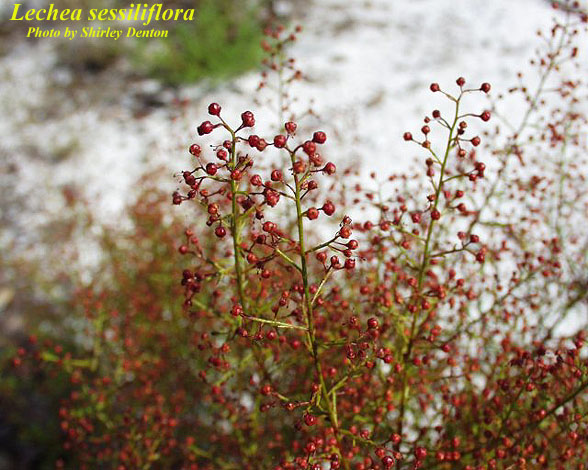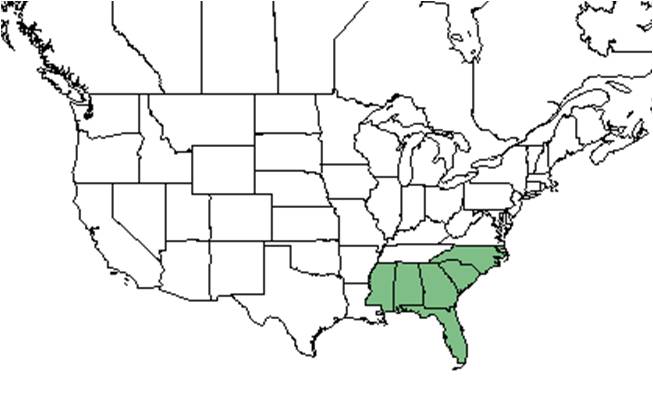Difference between revisions of "Lechea sessiliflora"
Emmazeitler (talk | contribs) (→Taxonomic notes) |
Emmazeitler (talk | contribs) |
||
| Line 18: | Line 18: | ||
}} | }} | ||
| − | Common name: Pineland pinweed | + | Common name: Pineland pinweed<ref name="weakley">Weakley, A.S. 2015. Flora of the southern and mid-atlantic states. Working Draft of 21 May 2015. University of North Carolina at Chapel Hill, Chapel Hill, North Carolina.</ref> |
==Taxonomic notes== | ==Taxonomic notes== | ||
Synonyms: ''Lechea patula'' Leggett; ''L. exserta'' Small; ''L. prismatica'' Small.<ref name="weakley">Weakley, A.S. 2015. Flora of the southern and mid-atlantic states. Working Draft of 21 May 2015. University of North Carolina at Chapel Hill, Chapel Hill, North Carolina.</ref> | Synonyms: ''Lechea patula'' Leggett; ''L. exserta'' Small; ''L. prismatica'' Small.<ref name="weakley">Weakley, A.S. 2015. Flora of the southern and mid-atlantic states. Working Draft of 21 May 2015. University of North Carolina at Chapel Hill, Chapel Hill, North Carolina.</ref> | ||
| Line 24: | Line 24: | ||
Varieties: none.<ref name="weakley">Weakley, A.S. 2015. Flora of the southern and mid-atlantic states. Working Draft of 21 May 2015. University of North Carolina at Chapel Hill, Chapel Hill, North Carolina.</ref> | Varieties: none.<ref name="weakley">Weakley, A.S. 2015. Flora of the southern and mid-atlantic states. Working Draft of 21 May 2015. University of North Carolina at Chapel Hill, Chapel Hill, North Carolina.</ref> | ||
| − | ''Lechea'' species can be hard to distinguish from each other due to microscopic differences, this often leads to problems with correct nomenclature. <ref name=bar> Barringer, K. (2004). "New Jersey Pinweeds (Lechea, Cistaceae)." The Journal of the Torrey Botanical Society 131(3): 261-276.</ref> | + | ''Lechea'' species can be hard to distinguish from each other due to microscopic differences, this often leads to problems with correct nomenclature.<ref name=bar> Barringer, K. (2004). "New Jersey Pinweeds (Lechea, Cistaceae)." The Journal of the Torrey Botanical Society 131(3): 261-276.</ref> |
==Description== | ==Description== | ||
| Line 35: | Line 35: | ||
Habitats include longleaf pine-wiregrass communities, pine-scrub oak barrens, coastal scrubs, and dry pine flatwoods. It has been found in disturbed areas such as cutover pine communities, sandy roadsides, former live oak plantations and along railroad tracks. ''L. sessiliflora'' responds negatively to soil disturbance by agriculture in Southwest Georgia.<ref>Kirkman, L.K., K.L. Coffey, R.J. Mitchell, and E.B. Moser. Ground Cover Recovery Patterns and Life-History Traits: Implications for Restoration Obstacles and Opportunities in a Species-Rich Savanna. (2004). Journal of Ecology 92(3):409-421.</ref> | Habitats include longleaf pine-wiregrass communities, pine-scrub oak barrens, coastal scrubs, and dry pine flatwoods. It has been found in disturbed areas such as cutover pine communities, sandy roadsides, former live oak plantations and along railroad tracks. ''L. sessiliflora'' responds negatively to soil disturbance by agriculture in Southwest Georgia.<ref>Kirkman, L.K., K.L. Coffey, R.J. Mitchell, and E.B. Moser. Ground Cover Recovery Patterns and Life-History Traits: Implications for Restoration Obstacles and Opportunities in a Species-Rich Savanna. (2004). Journal of Ecology 92(3):409-421.</ref> | ||
| − | Associated species include ''Dalea, Eupatorium, Liatris, Pityopsis, Symphotrichum'', and ''Schizachyrium''. Soil types include loamy sand and sand. <ref name="FSU Herbarium">Florida State University Robert K. Godfrey Herbarium database. URL: [http://herbarium.bio.fsu.edu http://herbarium.bio.fsu.edu]. Last accessed: October 2015. Collectors: C. Anderson, M. Davis, Robert K. Godfrey, R. Komarek, H. Roth. States and Counties: Florida: Calhoun, Franklin, Gadsden, Gulf, Jackson, Leon, Suwannee, Taylor, Wakulla, Walton. Georgia: Grady. Compiled by Tall Timbers Research Station and Land Conservancy.</ref> | + | Associated species include ''Dalea, Eupatorium, Liatris, Pityopsis, Symphotrichum'', and ''Schizachyrium''. Soil types include loamy sand and sand.<ref name="FSU Herbarium">Florida State University Robert K. Godfrey Herbarium database. URL: [http://herbarium.bio.fsu.edu http://herbarium.bio.fsu.edu]. Last accessed: October 2015. Collectors: C. Anderson, M. Davis, Robert K. Godfrey, R. Komarek, H. Roth. States and Counties: Florida: Calhoun, Franklin, Gadsden, Gulf, Jackson, Leon, Suwannee, Taylor, Wakulla, Walton. Georgia: Grady. Compiled by Tall Timbers Research Station and Land Conservancy.</ref> |
''Lechea sessiliflora'' is an indicator species for the Peninsula Xeric Sandhills community type and is frequent and abundant in the North Florida SUbxeric Sandhills community type as described in Carr et al. (2010).<ref>Carr, S.C., K.M. Robertson, and R.K. Peet. 2010. A vegetation classification of fire-dependent pinelands of Florida. Castanea 75:153-189.</ref> | ''Lechea sessiliflora'' is an indicator species for the Peninsula Xeric Sandhills community type and is frequent and abundant in the North Florida SUbxeric Sandhills community type as described in Carr et al. (2010).<ref>Carr, S.C., K.M. Robertson, and R.K. Peet. 2010. A vegetation classification of fire-dependent pinelands of Florida. Castanea 75:153-189.</ref> | ||
| Line 43: | Line 43: | ||
===Seed dispersal=== | ===Seed dispersal=== | ||
| − | This species is thought to be dispersed by gravity. <ref>Kirkman, L. Katherine. Unpublished database of seed dispersal mode of plants found in Coastal Plain longleaf pine-grasslands of the Jones Ecological Research Center, Georgia.</ref> | + | This species is thought to be dispersed by gravity.<ref>Kirkman, L. Katherine. Unpublished database of seed dispersal mode of plants found in Coastal Plain longleaf pine-grasslands of the Jones Ecological Research Center, Georgia.</ref> |
===Seed bank and germination=== | ===Seed bank and germination=== | ||
| − | Kirkman found the vulnerability ratio for soil disturbance to be 3/3(reference sites/recovery sites). <ref name=kay> Kirkman, L. K., K. L. Coffey, et al. (2004). "Ground Cover Recovery Patterns and Life-History Traits: Implications for Restoration Obstacles and Opportunities in a Species-Rich Savanna." Journal of Ecology 92(3): 409-421.</ref> | + | Kirkman found the vulnerability ratio for soil disturbance to be 3/3(reference sites/recovery sites).<ref name=kay> Kirkman, L. K., K. L. Coffey, et al. (2004). "Ground Cover Recovery Patterns and Life-History Traits: Implications for Restoration Obstacles and Opportunities in a Species-Rich Savanna." Journal of Ecology 92(3): 409-421.</ref> |
<!--===Fire ecology===--> <!--Fire tolerance, fire dependence, adaptive fire responses--> | <!--===Fire ecology===--> <!--Fire tolerance, fire dependence, adaptive fire responses--> | ||
===Pollination=== | ===Pollination=== | ||
| − | The following Hymenoptera families and species were observed visiting flowers of ''Lechea sessiliflora'' at Archbold Biological Station: <ref name="Deyrup 2015">Deyrup, M.A. and N.D. 2015. Database of observations of Hymenoptera visitations to flowers of plants on Archbold Biological Station, Florida, USA.</ref> | + | The following Hymenoptera families and species were observed visiting flowers of ''Lechea sessiliflora'' at Archbold Biological Station:<ref name="Deyrup 2015">Deyrup, M.A. and N.D. 2015. Database of observations of Hymenoptera visitations to flowers of plants on Archbold Biological Station, Florida, USA.</ref> |
Halictidae: ''Lasioglossum placidensis'' | Halictidae: ''Lasioglossum placidensis'' | ||
Revision as of 19:04, 17 September 2020
| Lechea sessiliflora | |
|---|---|

| |
| Photo by Shirley Denton (Copyrighted, use by photographer’s permission only), Atlas of Florida Vascular Plants | |
| Scientific classification | |
| Kingdom: | Plantae |
| Division: | Magnoliophyta - Flowering plants |
| Class: | Magnoliopsida - Dicotyledons |
| Order: | Fabales |
| Family: | Cistaceae |
| Genus: | Lechea |
| Species: | L. sessiliflora |
| Binomial name | |
| Lechea sessiliflora Raf. | |

| |
| Natural range of Lechea sessiliflora from USDA NRCS Plants Database. | |
Common name: Pineland pinweed[1]
Contents
Taxonomic notes
Synonyms: Lechea patula Leggett; L. exserta Small; L. prismatica Small.[1]
Varieties: none.[1]
Lechea species can be hard to distinguish from each other due to microscopic differences, this often leads to problems with correct nomenclature.[2]
Description
L. sessiliflora is a herbaceous perennial distinguished from other Lechea species by having a conspicuously exserted, ellipsoid capsule that is capped by a reddish-brown fimbriate stigma.[3] The species in Lechea have a distinctive calyx with the two outer sepals very different in size and shape from the three inner sepals.[2] It is often mistaken for L. deckertii because both species have prominently exserted straw-colored capsules with persistent stigmas. The easiest way to distinguish these two species is by the length of the outer slender sepals and the shape of the capsules. L. sessiliflora has ellipsoid capsules and the narrow outer sepals are almost equaling or a little longer than the broad inner sepals.[3]
Distribution
Ecology
Habitat
Habitats include longleaf pine-wiregrass communities, pine-scrub oak barrens, coastal scrubs, and dry pine flatwoods. It has been found in disturbed areas such as cutover pine communities, sandy roadsides, former live oak plantations and along railroad tracks. L. sessiliflora responds negatively to soil disturbance by agriculture in Southwest Georgia.[4]
Associated species include Dalea, Eupatorium, Liatris, Pityopsis, Symphotrichum, and Schizachyrium. Soil types include loamy sand and sand.[5]
Lechea sessiliflora is an indicator species for the Peninsula Xeric Sandhills community type and is frequent and abundant in the North Florida SUbxeric Sandhills community type as described in Carr et al. (2010).[6]
Phenology
L. sessiliflora has been observed flowering in February and August through October and fruiting in October.[5][7]
Seed dispersal
This species is thought to be dispersed by gravity.[8]
Seed bank and germination
Kirkman found the vulnerability ratio for soil disturbance to be 3/3(reference sites/recovery sites).[9]
Pollination
The following Hymenoptera families and species were observed visiting flowers of Lechea sessiliflora at Archbold Biological Station:[10]
Halictidae: Lasioglossum placidensis
Conservation and management
Cultivation and restoration
Photo Gallery
References and notes
- ↑ 1.0 1.1 1.2 Weakley, A.S. 2015. Flora of the southern and mid-atlantic states. Working Draft of 21 May 2015. University of North Carolina at Chapel Hill, Chapel Hill, North Carolina.
- ↑ 2.0 2.1 Barringer, K. (2004). "New Jersey Pinweeds (Lechea, Cistaceae)." The Journal of the Torrey Botanical Society 131(3): 261-276.
- ↑ 3.0 3.1 [[1]]Accessed January 11, 2016
- ↑ Kirkman, L.K., K.L. Coffey, R.J. Mitchell, and E.B. Moser. Ground Cover Recovery Patterns and Life-History Traits: Implications for Restoration Obstacles and Opportunities in a Species-Rich Savanna. (2004). Journal of Ecology 92(3):409-421.
- ↑ 5.0 5.1 Florida State University Robert K. Godfrey Herbarium database. URL: http://herbarium.bio.fsu.edu. Last accessed: October 2015. Collectors: C. Anderson, M. Davis, Robert K. Godfrey, R. Komarek, H. Roth. States and Counties: Florida: Calhoun, Franklin, Gadsden, Gulf, Jackson, Leon, Suwannee, Taylor, Wakulla, Walton. Georgia: Grady. Compiled by Tall Timbers Research Station and Land Conservancy.
- ↑ Carr, S.C., K.M. Robertson, and R.K. Peet. 2010. A vegetation classification of fire-dependent pinelands of Florida. Castanea 75:153-189.
- ↑ Nelson, G. PanFlora: Plant data for the eastern United States with emphasis on the Southeastern Coastal Plains, Florida, and the Florida Panhandle. www.gilnelson.com/PanFlora/ Accessed: 12 DEC 2016
- ↑ Kirkman, L. Katherine. Unpublished database of seed dispersal mode of plants found in Coastal Plain longleaf pine-grasslands of the Jones Ecological Research Center, Georgia.
- ↑ Kirkman, L. K., K. L. Coffey, et al. (2004). "Ground Cover Recovery Patterns and Life-History Traits: Implications for Restoration Obstacles and Opportunities in a Species-Rich Savanna." Journal of Ecology 92(3): 409-421.
- ↑ Deyrup, M.A. and N.D. 2015. Database of observations of Hymenoptera visitations to flowers of plants on Archbold Biological Station, Florida, USA.